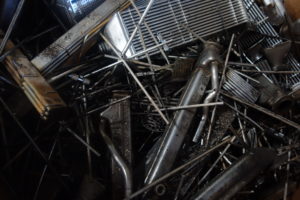Does your Maricopa County manufacturing business create excess scrap metal? If you aren’t doing so already, it may be time for scrap metal recycling.
Why Recycle Steel Scrap Metal?
Recycling can benefit your business financially as well as lower your carbon footprint with this easy, sustainable practice. Steel is the most recycled metal in North America and is very easy to come by. Your business may produce steel waste that you don’t even know about. For instance, 100% of steel roofing can be recycled. Automobiles, appliances, food and beverage packaging, as well as a wide range of pieces from large commercial projects.
Plastic takes about 1,000 years to break down while steel only takes up to 100 years to fully decompose in a landfill. Make the eco-friendly choice for your business and consider recycling your scrap steel and purchasing already recycled materials or products.
Steps to Recycling Industrial Steel Scrap Metal
- Collecting Your Scrap Metal – Your metals are placed in special recycling bins by industrial workers for pick up or they will be dropped off at your local recycling plant directly.
- Sorting – It’s essential that your metals get sorted correctly at your recycling plant. This is done by a magnetic system to separate the recyclable metals from the non-recyclable ones. This type of quality-control sorting is important as it will result in an end product with the desired, specific metal. The quality of the steel could lower in value if certain non-recyclable counterparts are involved. If you are running a manufacturing or industrial business that uses steel machinery or products, you will understand that the highest quality metals are essential.
- Compacting – Special machinery breaks and crushes the recycled metal to minimize the overall volume of the scrap for an efficient turnaround.
- Shredding – These smaller batches are now shredded into smaller, more manageable pieces which require less energy to process and can minimize carbon dioxide emissions.
- Heating – These shreds of steel are burned into liquid steel. This can take from a few minutes to several hours depending on the alloying elements present in the scrap. The magnitude of the heat as well as the amount of steel being heated will change the heating time overall.
- Refining – Impurities such as dirt, debris, and particles are eliminated through the refining process. Depending on the recycling plant’s preferred method of purification, techniques that could be used are distillation, electrolysis, zone refining, and chromatography. Depending on the method used, the end result may vary.
- Solidifying – The pure melted steel now goes on to be cooled and solidified. Specialized machinery takes the hot, molten metal from the heating and purification chambers to the cooling containers. In order to balance and preserve the molten steel’s desired properties (density, weight, corrosion resistance, etc.), chemical compounds may be added. Specially shaped containers are then used to mold the molten steel into structural steel in varying shapes and sizes. Depending on the industry, it could be made into a beam form, piping, angle stock, or bar stock.
Learn More about Recycling Steel Scrap Metal
Need Help Recycling YOUR Scrap Metals?
CRI has been serving Phoenix area communities for over 30 years. During that time we have built a reputation based on unwavering integrity, excellent customer service, and consistent innovation. Give us a call today to find out what Orange & Blue can do for you!






